By Luca Seidenari
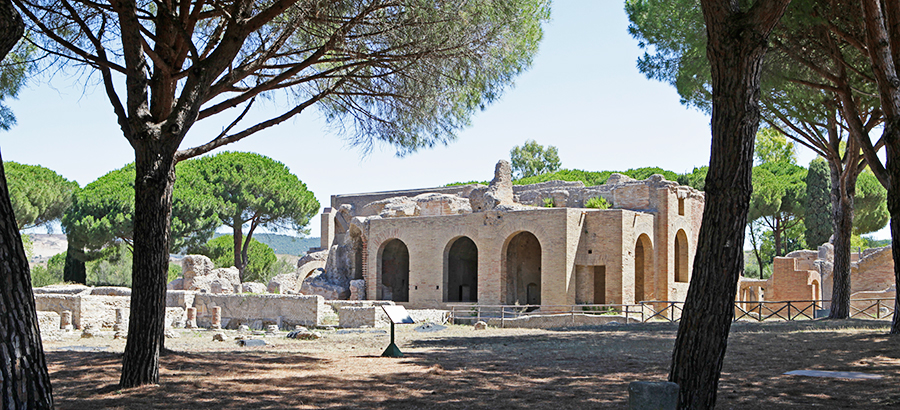
The archaeological complex of these baths, also known as the Baths of Trajan, is located about 4 km east of the centre of modern Civitavecchia on a hill alongside the old road to Tolfa. The Roman baths were erected in the vicinity of a well with sulphurous water. The use of this well goes back to ancient times: the therapeutic effects were already known in prehistory. Although the Etruscans also used the thermal water, its use was optimized for the first time by the Romans.
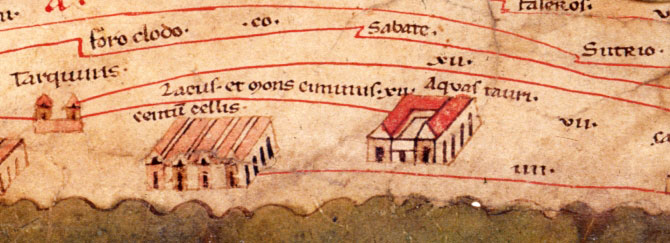
(a XII-XIII century copy of an ancient Roman map)
The bathhouse complex owes its name to a small Etruscan-Roman village, called Aquae Tauri, near the Colle della Ficoncella. There is however a legend about the name, recorded by the Roman poet Rutilius Namatianus, a former Roman prefect who visited the baths in 416 AD. According to this legend a bull (taurus in Latin) would have scraped the ground with its hoof, as bulls do before a fight. On that spot a well, giving sulphurous water, appeared. The bull would be the personalization of a god, probably Jupiter, Rome’s most important god. The poet also referred to Greek mythology to substantiate this hypothesis, because it says that only a god has the power to create a thermal well. This was also the logical explanation for the Romans of why the quality of the water was extremely high.
The other name of the bathhouses, Baths of Trajan, is due to a wrong interpretation of the ruins. For many years the ruins of the Roman complex were seen as the remains of the large villa that the emperor Trajan had built in the neighbourhood in the first half of the second century AD. Pliny the Younger already wrote about this villa (read also the article ‘Centumcellae, the port of Trajan’). Today this villa is located on a hill called Belvedere, about one kilometre from the coast in a military zone.
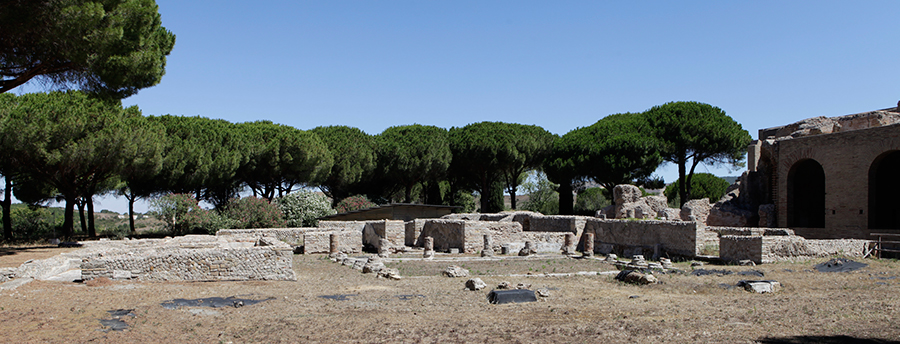
The earliest excavations of this archaeological terrain date back to 1777 on account of the Roman Catholic Diocese. However real investigation started during the twentieth century. The visible remains can be divided into two separate parts, built in different times: the so-called Republican Baths, realised in the middle of the first century AD, with walls made of small diamond-shape stones, called ‘opus reticulatum’, and the Imperial Baths, erected between 123 and 139 AD by Hadrian and recognizable by the use of bricks. Of course many restorations and changes have taken place in the course of time. During the empire there was a remarkable influx of people, either from Rome or from other regions by the presence of the harbour of Centumcellae (Civitavecchia) and of the emperor’s villa. The decline of the empire at the end of the fifth century soon caused the end of the use of the bath complex. Perhaps there was a bit of a revival between the fifth and sixth century under Theodoric the Great. After that period, probably caused by the long war between Byzantium and the Goths on this place, the baths became officially and permanently out of use. It is however likely that the exploitation of the baths never stopped completely. After all, the water kept streaming through the buildings and later the ruins. During groundwork in the large imperial caldarium (hot water bath) pieces of a bath tub from the sixth century, the time after the official closing, have been found.
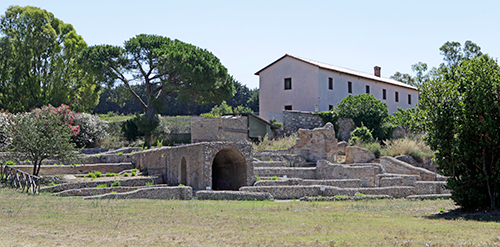
At the archaeological site several places still have to be excavated. Of the republican baths the area at the northwest side has to be explored, while the imperial bathhouse has still unexplored ground at the place where a large house was built in the 18th century, and in the area at the west side of the complex. The total area originally was no less than 20.000 square meters. The buildings were covered with ornaments of fine marble, were equipped with statues, had coloured plaster, frames, reliefs, frescoes, columns and travertine capitals. Unfortunately, of all these only a few pieces have been found.
Besides the thermal water which rose from underneath the ground, the water supply was organized by several small water streams brought together via an aqueduct into a cistern (water reservoir) located at a short distance from the baths. The whole complex was provided with water by a properly functioning system consisting of underground tunnels, corridors, lead pipes and a drain.
Description of the Republican Baths
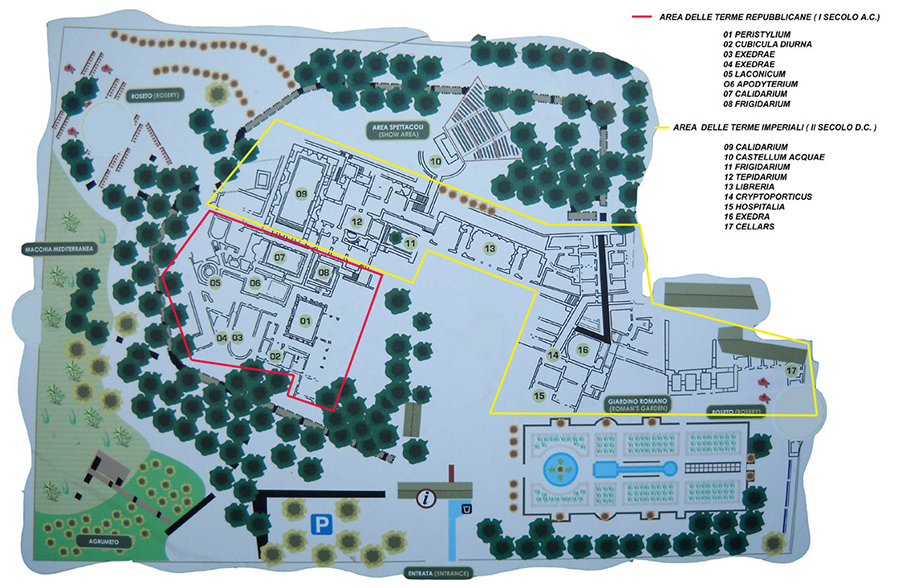 These baths are divided in two wings: the actual baths, and an area composed of different kinds of rooms, where complementary activities, such as social and business meetings and therapeutic treatments, took place.
These baths are divided in two wings: the actual baths, and an area composed of different kinds of rooms, where complementary activities, such as social and business meetings and therapeutic treatments, took place.
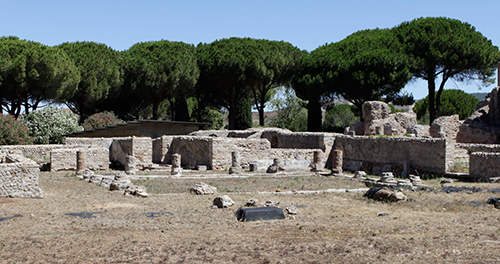
These rooms were accessible via a peristylium (central court) surrounded by a gallery of octagonal columns with a brick core, plastered and originally covered by travertine capitals.
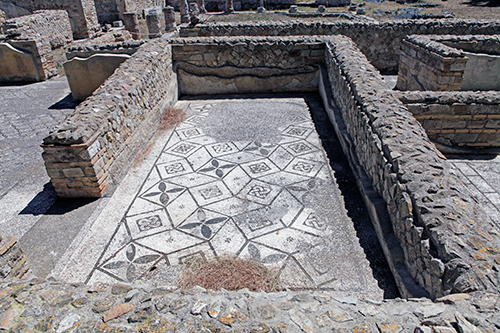
At the west side of the peristylium are many small rooms, so-called cubicula diurna (rooms for the day), completely paved with a mosaic floor and used as small resting rooms where one could lay down on a bed after the baths, have therapeutic treatments or a massage.
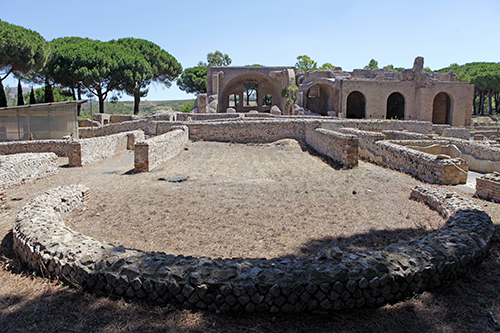
The other room at the north side, of the same size, was an exedra (semicircular hall). Inside the large semicircular apse chairs were placed, where visitors of the baths could rest or start a conversation. Another semicircular room, similar but a little bit smaller, was separated from the latter room by a corridor. It was called the ‘small exedra’. If we continue through a large corridor, paved with small pieces of terracotta in a fishbone pattern (opus spicatum) we enter a large room with a partially surviving mosaic floor depicting stars and diamonds. This room was meant as a kind of atrium (front hall) of the actual baths.
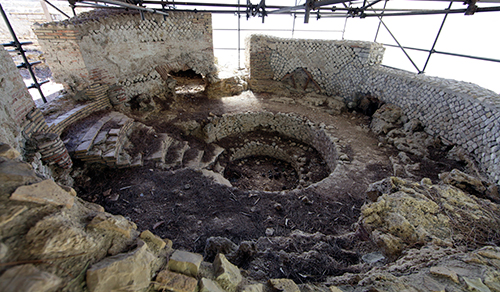
Adjacent was the round laconicum or sudatorium (sweat bath). This is probably the oldest still existing room of the Terme Taurine, dating back to the second century BC. The walls of the laconicum were built with small irregular stones in an unprecise pattern (opus incertum). Originally there was a free-standing tub in the middle of the room, in which high temperature thermal water was flowing. Along the walls was a bench covered with travertine plates. People could sit down after diving into the hot water.
In the time of Hadrian the tub was filled up with stones and bricks and the travertine bench broken down. Next, small brick columns were placed on the bottom to support a marble floor, still partly visible. In the empty space created between the columns under the floor hot air could circulate. This air was obtained by burning wood in a special furnace (praefurnium). The room, probably covered with a dome, was used as a sweat bath.
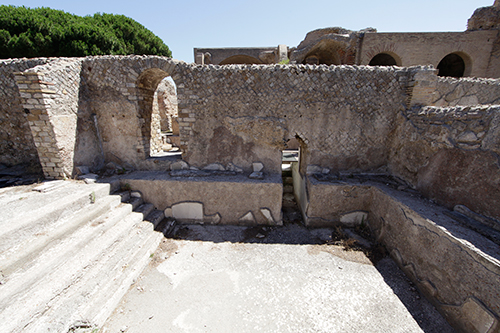
From this sweat room you entered a latrine via a small corridor and after that a room where the apodyterium (dressing room) must have been. After the apodyterium, where several small tubs were placed for feet washing, you walked directly into the first large bath, with a mosaic floor and covered with marble plates, called the tepidarium (semi-hot water bath). From this bath you could reach the warm water bath (caldarium) directly through a passage in the wall covered with marble.
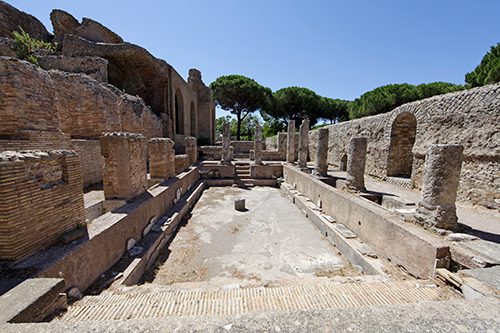
The caldarium is highly interesting because of its basilica shape: divided in three parts by two rows of columns decorated with plaster. In the period of Hadrian this room too was modified: to obtain maximum strength of the construction, the columns were replaced by or embedded in brick pillars. The original roof was replaced by an enormous ceiling called ‘opera a padiglione’ (a ceiling built up from many squares) below which an accessible terrace was created.
The caldarium was almost completely occupied by a large tub with smaller tubs on three sides. Because the overflowing thermal water was collected in the smaller tubs, the water in the central bath was kept on a permanent level. The room was very richly decorated with marble and ionic capitals.
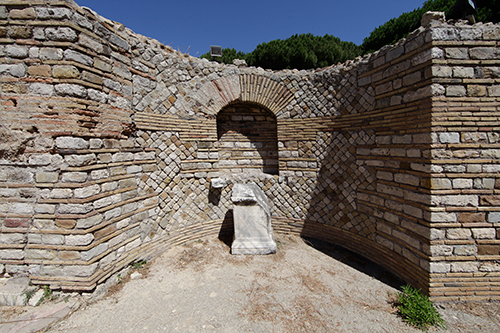
In the centre of the almost completely reconstructed apse is a square niche with two marble plates on both sides once supporting small columns, undeniably used as an aedicula (enclosure) in which an image of the protective goddesses, the nymphs, was placed. For the Romans each well, and especially a thermal well, was sacred. In the proximity of the aedicula a large marble votive altar has been found. The altar, dedicated to the nymphs and erected by a certain Alcibiades, a freedman of the emperor Hadrian, is now found in the apse.
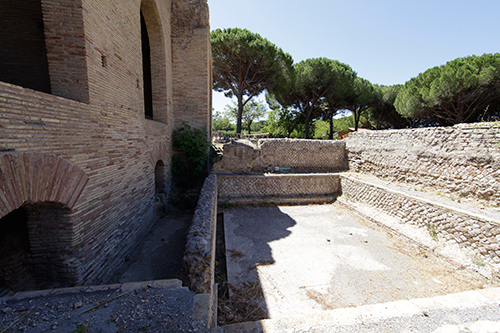
At the south side of the caldarium we find another basin with a mosaic floor. This one dates from a later time, probably the time of the Flavian emperors, and was fed from the caldarium.
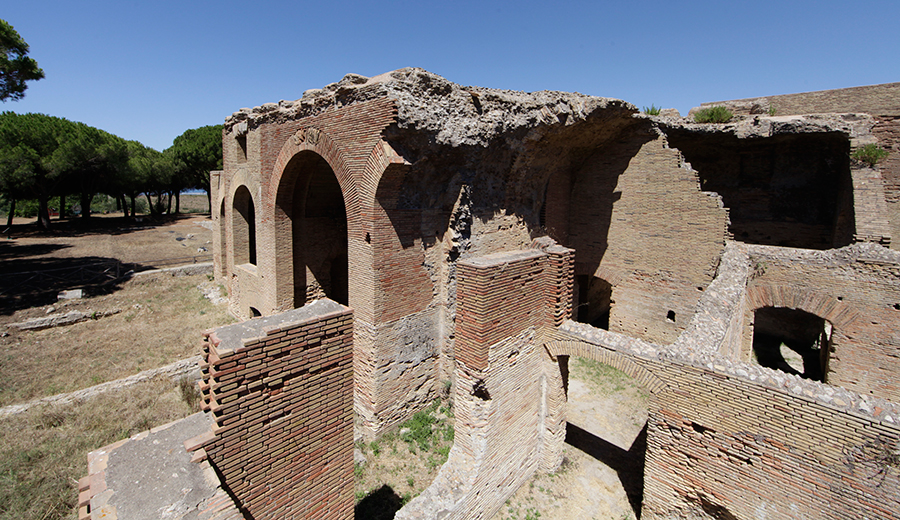
Description of the Imperial Baths
The entrance of the imperial thermal complex can be reached via a small staircase leading to a corridor with windows, which in turn leads to the entrance hall of the baths. Here one could buy a ticket (balneaticum) and gave part of one's cloths in custody to a specially appointed person who was responsible for the dressing room (a capsarius).
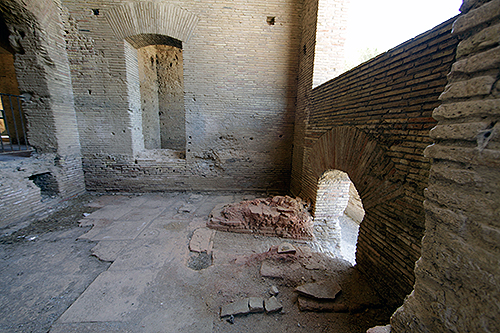
Near the entrance was a latrine which, like all the other latrines in the complex, was equipped with seats with a hole, and placed below a niche. Under the seats water was flowing permanently and drained towards a sewing channel. After the latrines you entered the dressing rooms, where the floors were heated by the so-called hypocaustum system. Parts of this system can still be seen. Underneath the floor, sustained by brick pillars, the hot air produced in a praefurnium (furnace) was blown. The warm air rose through hollow bricks set against the walls.
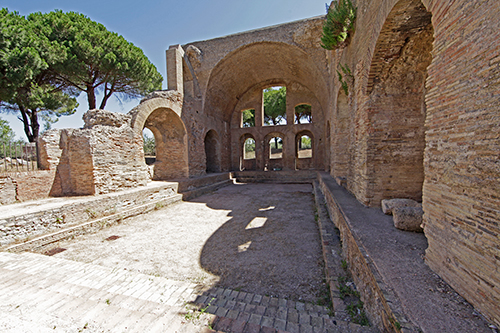
From the dressing rooms you could enter the caldarium via a corridor and several other rooms. This caldarium was the largest and most representative room of the whole complex. The bath was roofed by a cross-vault decorated with stucco and divided into panels. The walls were, like the tub, covered with marble plates. All niches had openings which, together with the windows, took care of the illumination of the large room. The windows were equipped with glass enclosed by wooden frames covered by lead.
After bathing, visitors could take a walk through several heated rooms until, in the last room, the transpiration caused by the caldarium was over. In still other rooms one could, for an additional fee, enjoy massages and other cures given by specialized people. After these rooms there was a less heated room in order to get slowly used to the outside temperature, before going outside to the cold water bath (the frigidarium).
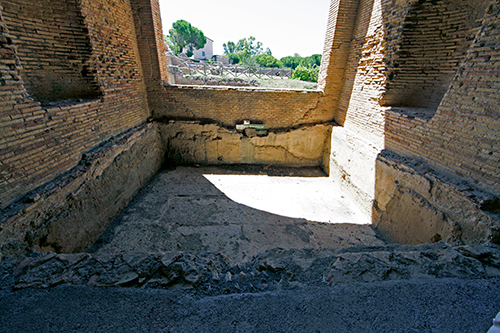
Before going outside there was another essential therapeutic treatment between the caldarium and the frigidarium, the tepidarium (the semi hot bath). The tepidarium was built in a room containing a large square tub below two niches for statues and a semicircular niche containing a small reservoir functioning as a shower. To make this bathroom work, a special room was set up, where today parts of the supports for the large water reservoirs, feeding the baths with water, can be seen. The water used in the tepidarium was not thermal, but transported directly from a cistern (water supply room from an aqueduct).
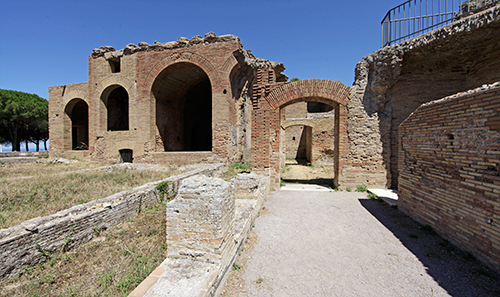
After being refreshed one could take a cold water bath. For this purpose, like in any other thermal bathhouse, there was an open air pool, called the frigidarium. Along three steps you walked into the bath. The last of the steps touched the water and was meant to be used as a bench. Along the west side some of the white marble lining has survived with which the bath was covered on the inside and outside.
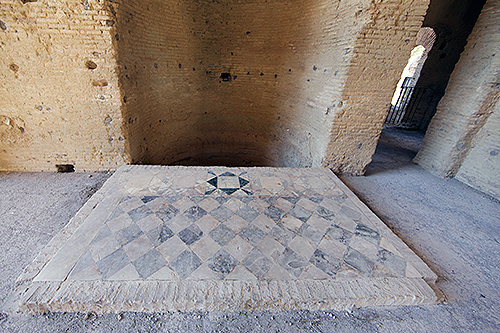
From the dressing rooms you could also enter directly another room with two protruding sections, with four windows at the south and west side. This room was heated by the sun and equiped with two different heating systems, the sun and the hypocaust below the floor and along the walls. This room was a sun terrace or heliocamus, where you could take a sweat bath with hot sand. In one of the protruding parts remains of a tub in which sand was stored survived. On the walls you can recognize some of the hollow bricks through which the hot air was distributed.
Near the entrance, under the first of two ramps leading to the upper floor, is a latrine for the servants with a partially surviving white mosaic floor. Of this part of the upper floor unfortunately little remains, as is true for most of the building. On the upper floor a large room flanked by accessible terraces is still recognizable, and some rooms positioned on a lower level. A part of the upper floor might have been used as a storage room for stuff like massage oil and towels. Right above the heliocaminus, at the south-west end, was probably a solarium.
The area at the south end of the Terme Taurine
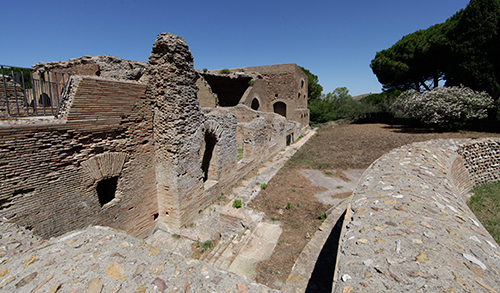
The thermal complex also had other facilities, like rooms for cultural activities and for the services at the south side of the baths. Between the thermal area at the north side and the rooms at the south side was the library. The library was a large room with eight rectangular niches, placed a little bit more than half a meter above the floor, containing shelves for the books and other papers collected in round containers. In the middle of the large back wall was a semicircular niche, probably used for a statue of Minerva, the goddess of art and science. The room was decorated with marble columns dividing the niches from each other, walls covered with several kinds of marble and a rich floor paved with porphyry squares. On both sides, in perfect symmetry, were first the latrines with associated vestibules, and two rooms used as reading rooms. In the alcoves in the back walls of these rooms probably beds were placed (lectus lucubratorius) on which people could read.
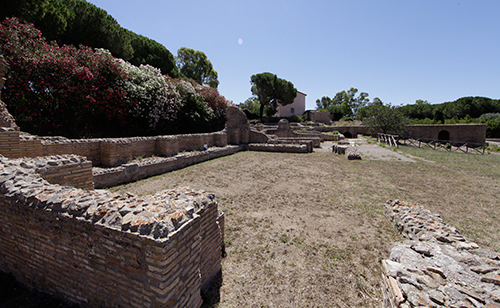
The library as well as the rooms next to it had access through an arcade formed by columns and pillars partly recognizable.
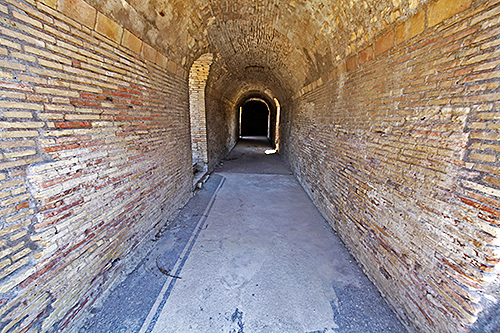
From this arcade you could descend via a staircase to a cryptoporticus (semi-subterranean gallery), perhaps meant for indoor promenades. Above the cryptoporticus were small rooms around a central corridor, probably used as a hospitalium (hostel) where guests of the baths could stay. At the south side of the cryptoporticus you find other rooms, partly with walls constructed in opus reticulatum (diamond shape tuff stones). Between these rooms was an exedra, which must have been decorated beautifully. In imperial times a hypocaustum heating system was created under the floor of the exedra.
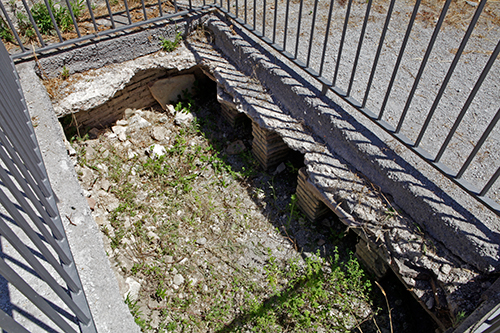
To the right side of the exedra was a ramp paved with mosaic, probably leading to the hospitalium. These small rooms were connected to some bigger rooms by a staircase. The bigger rooms must have been part of the library.
The building at the end was consisted of several rooms. Some of them served as a support for the protruding sections. In this area you also find several rooms used for storage. In many cases these buildings were damaged or completely destroyed by the newly built house from the 18th century and therefore hard to identify.
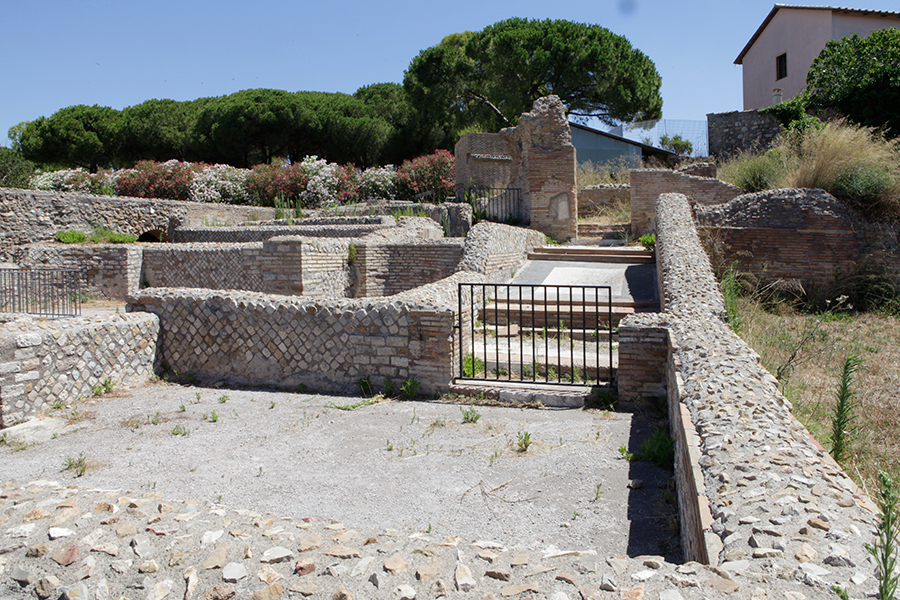






 We are committed to providing versions of our articles and interviews in several languages, but our first language is English.
We are committed to providing versions of our articles and interviews in several languages, but our first language is English.